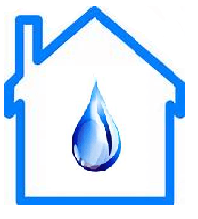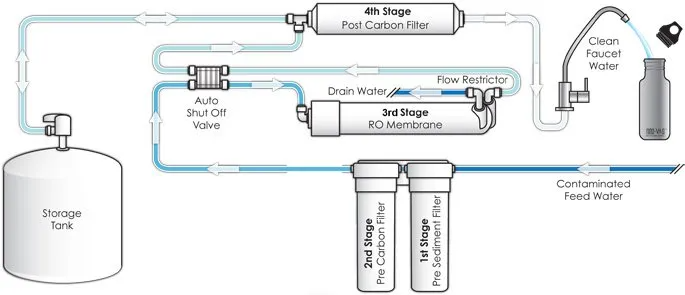Reverse Osmosis Systems
Reverse Osmosis Drinking Water Systems
Often we are asked, "Why do I need to purchase a Reverse Osmosis Drinking Water System and exactly what does the system do?"
The answer to that question is pretty simple and complex at the same time, the reverse osmosis drinking water system typically found in most homes are designed to be installed under the kitchen sink, a connected to the cold water supply line is made to feed the drinking water system and from there the water goes thru a set of filters before reaching the RO membrane. The RO membrane is a thin film composite filter that is selective in what can pass thru the filter, bigger ions (read minerals) can not pass thru the membrane pores because they are to large and as a result those minerals go out in the waste stream and down the drain. The finished water, call product water, is then sent to a storage tank where it is held until needed. Once you open that dedicated faucet to get a glass of water then the water passes thru a polishing carbon filter (post carbon) before being dispensed.
Now under ideal conditions most home reverse osmosis drinking water systems will reject around 97% of the minerals entering the system under ideal conditions (water temperature and pressure). If you drink bottled water check the label and chances are you are drinking Reverse Osmosis prepared water with possibly minerals added back in for taste, but that's another story. Almost all of the major water companies offer some kind of reverse osmosis drinking water and the equipment that they use to make that water is just a larger scale of what you can find under your sink.
So that is how a reverse osmosis drinking water works, now onto the harder question, do you need to own one. And the answer to that is, well it depends, it depends on the quality of the water entering your home, it depends on whether or not your water has a bad taste, does it taste like chlorine, does it taste dirty or is your water keeping you from drinking your recommended 64 oz of water per day. Also are you already buying water from the store or having 5 gallon bottles delivered to your home. If any of these are true then YES you need a Reverse Osmosis Drinking Water System installed in your home.
Reverse Osmosis Drinking Water is great for not only drinking but for cooking, making coffee, teas or anything else you normally mix with water.
Typical Water Flow In A Reverse Osmosis Drinking Water System
Pre-filter (1st stage): This is the first point of contact for the untreated water. The pre-filter’s job is to remove the larger particles, and protect the filters that come after it (especially the reverse osmosis membrane). It mainly removes things like sediment, rust, and dirt.
Pre-filter (2nd & 3rd stage): The carbon filters’ main function is to remove chlorine, and other organic chemicals from the water. These chemicals can have bad odors and tastes, so the carbon filters work to improve the taste and smell of the water too.
Automatic Shut-off Valve: When the storage tank reaches capacity, this valve will close and stop any more water from passing through. This prevents over-spill of the water tank.
RO Membrane (4th stage): This is where the system really earns its money, and the reverse osmosis process takes place. The membrane consists of a very fine material, which will typically only allow particles of a size smaller than 0.0005 microns (0.00000005 cm) to pass through.
Flow Restrictor: This has the job of regulating the water flow. The reverse osmosis process works best at higher water pressures, and this component helps with the systems efficiency.
Storage Tank: This is where your water is stored, prior to coming out of the faucet. Sizes range from around 3 gallons to 9 gallons.
Drain Line: This takes the by-product waste water away to the nearest drainage area.
Post filter (5th stage): Though not included in the picture, many RO systems will involve a further stage of filtration. This is an alkaline or pH filter, which works to add healthy minerals back to the water that may have been removed during the filtration process. It also serves to raise the pH to more alkaline levels.



